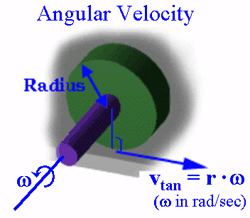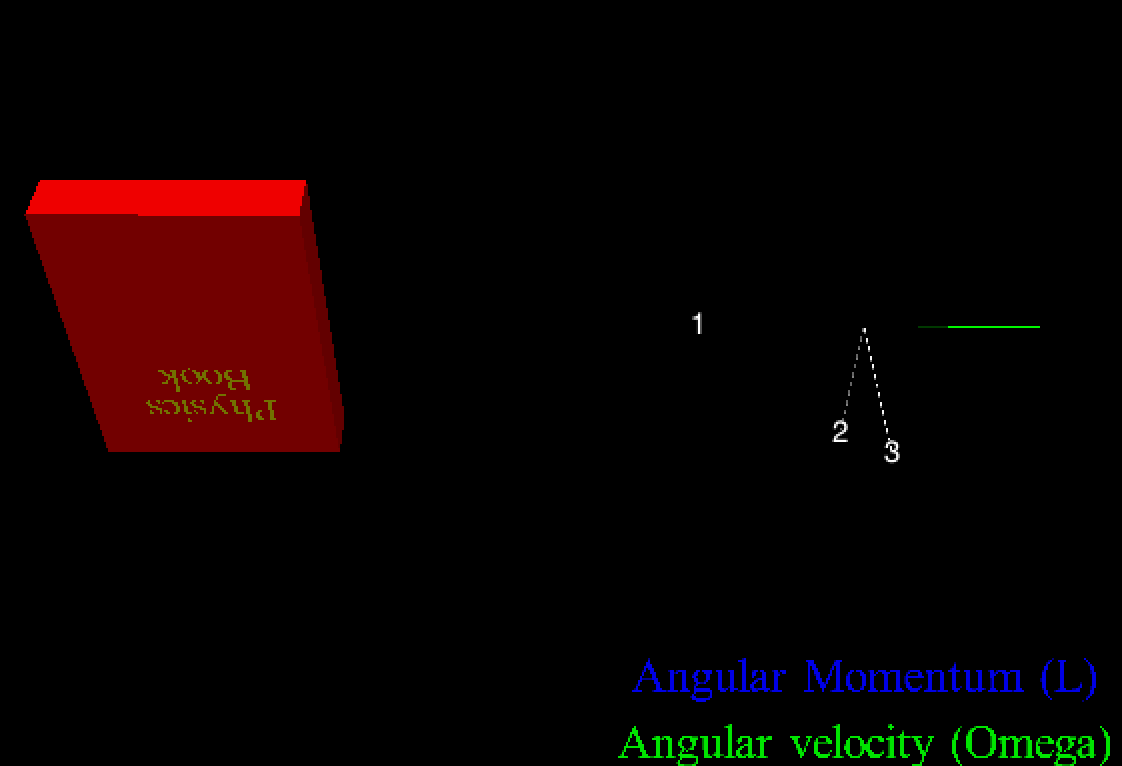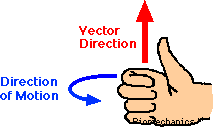Angular Velocity: Difference between revisions
Joshamathew (talk | contribs) No edit summary |
Joshamathew (talk | contribs) No edit summary |
||
| Line 36: | Line 36: | ||
Check out this code which gives an example of angular velocity. It is an example found http://vpython.org/contents/contributed/rotating_book.py | Check out this code which gives an example of angular velocity. It is an example found http://vpython.org/contents/contributed/rotating_book.py | ||
[[File:Screenshot_2015-12- | [[File:Screenshot_2015-12-05_at_2.02.15_PM.png]] | ||
==Examples== | ==Examples== | ||
Revision as of 14:03, 5 December 2015
Angular Velocity describes the rate of change around a center of mass. It is measured in radians/second.
Angular Momentum also known as Rotational velocity
In order to find out the velocity of things which revolve around a body we have to take account not just speed but also the radius of which it is revolving around. The central angle in which objects rotate around is constantly changing, therefore that is why linear velocity is not adequate to measure the rate of change of the angle. Angular velocity is this rate of change with respect to time. In order to figure out the direction of angular velocity we can use the Right hand rule. It is important to note the definition of linear velocity, which is the rate of change of position measured in meters with respect to time. The only difference between the two is the fact that the object is rotating around something. The direction is perpendicular to the plane of the rotation. Often angular velocity is used to figure out rotational angular momentum and very useful when figuring out the speed of something rotating or orbiting around something.
A Mathematical Model
Angular Momentum of an object can be described as a the radius of the object of which it is rotating around its center of mass diveded by its linear velocity.
ω = dθ/dt
dθ= rate of change of the radians or degrees dt= rate of change of time throughout the interval
V perpendicular = mag(V)*sin(θ) V= linear velocity θ= Angle of which the linear velocity is going.
Thus after combining the two definitions we get
ω = R/v ω= The greek symbol of omega symbolizes angular velocity R= The radius of the body of which is rotates, measured in radians V= Linear Velocity
Also another we can compute angular velocity is if Angular Momentum is given. L = Iω L= Angular Momentum I = Moment of inertia ω = Angular Velocity
A Computational Model
How do we visualize or predict using this topic. Consider embedding some vpython code here Teach hands-on with GlowScript Check out this code which gives an example of angular velocity. It is an example found http://vpython.org/contents/contributed/rotating_book.py
Examples
Be sure to show all steps in your solution and include diagrams whenever possible
Simple
A circular wheel of 0.50 m radius is moving with a speed of 10 m/s. Find the angular velocity?
The angular velocity is given by ω = dθ/dt dθ= 10 dt= .5 = 20 rads/ sec
Middling
Difficult
Connectedness
Angular velocity is very useful when we need to figure out the angular momentum or even the rotational kinetic energy. Also it gives us another sense of how fast something is going, since linear velocity will not describe the velocity of something revolving. As most engineering majors are very physics intensive, it can be especially useful in practically any engineering application. Also it can also tell us certain aspects of a rotating object, or something going around a radius. Specifically to my major as an Industrial Engineer I can increase angular velocity and angular momentum to increase the efficiency in machinery which may be rotated and used to create products on an assembly line. A fairly interesting concept is that ballerinas and skaters use the conservation of angular momentum all of the time, in order to put on a show and spin faster they first out stretch their arms and one of their legs to increase their moment of inertia. Then to increase their spin or angular velocity they suddenly bring in their limbs therefore decreasing their moment of inertia, but due to the conservation of angular momentum their angular velocity increases to compensate for the decrease in the moment of inertia.
History
There is no person who officially "discovered" angular velocity. However ideas of angular momentum and inertia were initially formulated by Descartes, from there Issac Newton used it to help formulate his law of motions. When the two are put together law of conservation of momentum and also related Euler we also able to explicitly state that F=MA
See also
You should also check out the Right Hand Rule. Angular Momentum Linear Velocity
Further reading
Books, Articles or other print media on this topic
External links
http://jonathanturley.org/2013/12/29/the-cubli-laws-of-motion-and-angular-momentum-at-play/
http://whatis.techtarget.com/definition/angular-velocity-rotational-velocity
http://www.wired.com/2014/04/can-you-slow-down-a-day-using-angular-momentum/
References
This section contains the the references you used while writing this page



